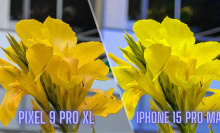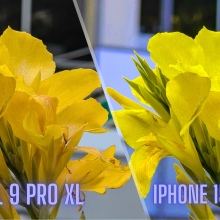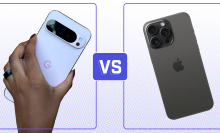Were you entranced by Apple's glamorous iPhone 12 keynote? Don't be because the new iPhone 12 lineup isn't all that different from last year's models. Aside from a new chipset and a few extra camera features, none of the phones really offer all that much in the way of upgrades.
I know what you're thinking: "But it has 5G, Brenda."
Yes, both the iPhone 12 and 12 Pro come with antennas to support the super-fast mobile network, but it's not all that useful yet. In fact, the large chunk of time Apple dedicated to touting 5G connectivity at its event felt more like a way to distract people from the new iPhones' incremental improvements.
The iPhone 12 and 12 Pro are also almost identical in specs. In addition to sharing a similar flat-edged design, they both have 6.1-inch Super Retina displays, A14 Bionic chips, 5G connectivity, and "all-day" battery life (but not really). With a starting price of $799 and $999 respectively, you're essentially paying an extra $200 for the additional camera and LiDar scanner on the 12 Pro. But don't let the 'Pro' moniker fool you — while the iPhone 12 costs less, it feels just as premium.
Having used the iPhone 11 and the iPhone 11 Pro as my daily drivers, my experience with the 12 and 12 Pro wasn't all that different. It wasn't until I compared specs on paper that I realized it wasn't just me — the iPhone 12 and iPhone 12 Pro are simply modest upgrades.
While the introduction of the iPhone X was revolutionary for the company, with its TrueDepth camera and (controversial) notch, new navigational gestures, and camera features like Portrait Mode, Apple now seems to be struggling to innovate on what is already a successful design.
It almost feels like when the iPhone 12 lineup was in production, Apple quite literally went with that well-known rhyme most brides use for good luck on their wedding day — Something old, something new, something borrowed, something blue — and hoped for the best.
A design that feels like a blast from the past
The iPhone 12 and 12 Pro do have "new" looks as compared to their predecessors, with flat edges that give them a very boxy frame. But it's not new for Apple as a whole since the design technically dates as far back as the iPhone 4 and the iPhone 5.

I was a huge fan of both of those phones in the past, so I'm very much on board with this design decision. Yes, it feels like a slab of metal in your hands, but the thicker edges make the devices feel as expensive as they actually are. And, while one might think that going with a somewhat recycled design would make for a dated form factor, it's actually a super refreshing change that feels durable and premium.
But while both phones have similar builds, there are subtle design differences: The iPhone 12 has a smooth glass back that comes in black, red, white, green, or blue, and the 12 Pro has a matte finish in either gold, silver, graphite, or blue.
To add to the new iPhone 12 line’s durability, Apple incorporated a new Ceramic Shield front cover on the display that it claims has four times the chance to survive a fall from your pocket without cracking the screen. Still, I'd recommend putting a screen protector on it. Even though the shield saved my iPhone 12 Pro from damage after it slid off my bed and onto the hardwood floor, it's still easy to scratch and scuff.
Speaking of the screen, both the iPhone 12 and iPhone 12 Pro feature 6.1-inch, 2532 x 1170 Super Retina XDR displays that look bright and vibrant. The bezels are also a lot thinner all around too, which certainly makes for a far better viewing experience when watching Netflix or scrolling through social media.
The inclusion of Super Retina XDR is to be expected for the 12 Pro, since it's no different from its predecessor, but it's a bit of a big deal for the iPhone 12. Both the iPhone 11 and iPhone XR included a Liquid Retina HD display that I never thought looked all that bad. Once I switched from the XR to the iPhone 11 Pro, however, I noticed a huge difference in sharpness and clarity. For someone like me, who consumes a lot of content on my phone, it's certainly an important factor in my buying decision.

There's no 120Hz refresh rate to be found on either of the iPhone 12 models. So, you're stuck with that 60Hz refresh rate instead. I wouldn't be so critical about this omission if that feature hadn't become the standard for almost every Android flagship phone out there right now. I was really hoping Apple would either follow suit or increase the refresh rate to 90Hz at least.
Fingers crossed for next year, I guess.
Enhanced sensors with a few new camera features

In addition to a new-ish design, Apple also included some new and improved sensors on both the iPhone 12 and iPhone 12 Pro.
The iPhone 12 has a dual-camera module with a 12-megapixel wide lens (f/1.6 aperture) and a 12-megapixel ultra-wide lens (f/2.4 aperture and a 120-degree field of view). The 12 Pro has the same lenses, but with the addition of a 12-megapixel telephoto lens that has a 52mm focal length (for 4x optical zoom) and a LiDar scanner. On the front, both phones have the same 12-megapixel TrueDepth camera.
The main upgrades to the iPhone cameras are really only useful for low-light environments.
With the iPhone 12, you can now use Night Mode with the ultra-wide-angle lens and in selfie mode. The iPhone 12 Pro allows you to take Night Mode Portrait shots. The LiDar scanner on the Pro also helps to improve autofocus up to 6x in low-light. Additionally, both phones have a lens correction setting that fixes lens distortion on the front-facing and ultra-wide cameras.
Below are a few camera samples of those Night Mode features in action on the iPhone 12 and 12 Pro.


With sensors that are 27 percent larger than the iPhone 11 Pro, the 12 Pro is also capable of capturing better low-light photos in standard camera mode as well. Below is an example of a Night Mode shot on the 12 Pro and a regular shot without it:


I also took some selfies in Night Mode with the iPhone 12 and the results are ... interesting.


It's impressive that it worked in some really dark environments as shown in the photos above. Without it, I probably wouldn't have had enough light to snap a clear photo, but I'd definitely edit my skin tone a bit before uploading to social media. It's not as harsh as taking a selfie with the flash on, but it's still a bit too much light for me.
Lastly, there's Night Mode with the ultra-wide-angle lens on the iPhone 12 which looks a bit grainy and blurry compared to standard wide-angle photos.


Since the camera sensors are similar on the iPhone 12 and 12 Pro, daytime photos between the two weren't all that different. But here are a few samples from both below:




Shots on both phones came out crisp and vibrant, and I didn't prefer one over the other during the day. But as I said before, a more in-depth camera comparison is on its way.
Smooth performance as usual, iffy battery life
With the new iPhone 12 lineup, Apple introduced its A14 Bionic chipset, which the company says is 40 percent faster than last year's chip. But that's to be expected each year with a new iPhone. And even though both phones run smoothly, I haven't noticed all that big of a difference in performance coming from the iPhone 11 and 11 Pro.

If you're upgrading from an older device with a previous chipset, like an iPhone XR or earlier, then it's highly likely you'll feel a jolt in speed when opening apps or scrolling through your phone. The LiDar scanner also helps to make sure those augmented reality apps run smoothly, too.
While it's supposed to be more efficient for battery life, I can't say the iPhone 12 Pro lasted me all that much longer than my 11 Pro. Even though I used both new iPhones simultaneously, I relied on the 12 Pro as my primary device since it included a SIM card. But both phones have the same "all-day" battery, so it's likely to last the same amount.
Since I'm not on my phone as often during this pandemic, the iPhone 12 Pro managed to power me through an entire day at home using apps like iMessage, Spotify, Twitter, Telegram, Messenger, and Instagram. But the day I took the phones out into the world for camera tests, the 12 Pro's "all-day" battery life fell short, lasting about seven and a half hours before reaching 22 percent.

The iPhone 11 Pro, on the other hand, can last me close to ten hours on a busy day.
But Apple's new MagSafe charging technology sort of makes up for its iffy battery life. Underneath each iPhone 12 is an array of magnets around the wireless charging coils. This not only makes it easy to clip the phone onto any of Apple's new wireless chargers, but can also power your phone up to 50 percent in 30 minutes.
Look, it's useful and certainly helps to quickly power your phone on days when you don't have time to sit around and wait for it to charge, but the MagSafe charger ($39) and accessories aren't included in the box. So, you're basically paying for a feature on the iPhone 12 that you might not even use.
5G doesn't matter... right now
I've dedicated a separate section to this because I really need to make one thing clear: Please do not buy the iPhone strictly for the 5G connectivity. The entire iPhone 12 lineup supports both sub-6 (the slower 5G network) and mmWave (the faster of the two), but that doesn't matter right now because neither of those are widely available. It's also important to note that if you do have 5G in your area, you'll also have to upgrade your carrier plans to access it.
For the purpose of this review, I should've tested 5G upload and download speeds with the new iPhone. But that would've required looking at a Verizon 5G coverage map and locating the cross streets where it's even available.

Trust me, I've played this game before — specifically with the Samsung Galaxy S20 Ultra back in February. I dragged my butt all over New York City to find a 5G sweet spot and kept hitting standard 4G LTE speeds. The same thing goes for the iPhone 12 or 12 Pro: It's not going to be as simple as stepping outside your door and immediately accessing those 5G speeds. And I'm sorry to break it to you, but it won't be easily accessible for a couple of years.
Those of us who are lucky enough to stay indoors during this pandemic don't need such fast speeds anyway since it's likely you're connected to Wi-Fi. Having that 5G connectivity built into your phone is more of a future-proof perk if you don't plan on upgrading your device for a very long time. But it's definitely not the sole reason to abandon your current device.
It's worth the upgrade if you really need it
There's no denying that the iPhone 12 and iPhone 12 Pro are Apple's most advanced phones to date. But once you cut through all of the fancy marketing jargon, you're really just getting a new chipset, marginally improved camera sensors, a few new camera features, and a boxy form factor. I'm leaving 5G completely out of this because, well, it's just too soon.

The iPhone 12 lineup is really only a worthy purchase if you're coming from an iPhone that you've had for years, like the iPhone X or prior. That way, the new features will actually be considered sizable upgrades rather than minor improvements.
And, for those of you deciding between the iPhone 12 and the 12 Pro, the iPhone 12 is more than enough for your daily needs. Unless you're a creative that relies heavily on your iPhone to capture photos and videos or you tend to use a lot of augmented reality apps, you're probably not going to get your money's worth with the Pro.
Maybe next year Apple can actually impress us with some revolutionary changes to the iPhone, and not rely on slickly produced presentations to distract us from what's really just a mediocre next-generation iPhone.




















